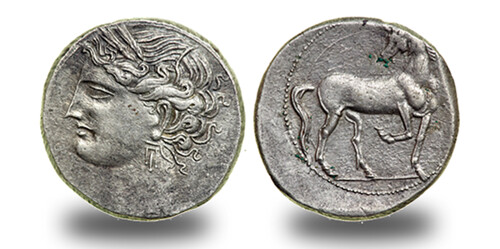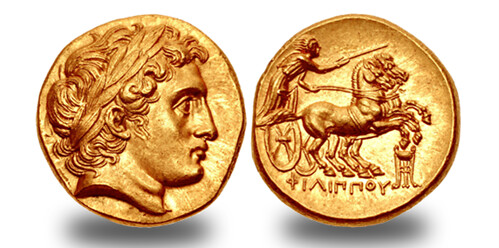
PREV ARTICLE
NEXT ARTICLE
FULL ISSUE
PREV FULL ISSUE
HORSES ON ANCIENT COINS
Mike Markowitz published a nice article about horses on ancient coins on CoinWeek April 12, 2016. Here's an excerpt - be sure
to read the complete article online. -Editor
MORE THAN ANY OTHER ANIMAL (except perhaps the dog), the horse is beloved for its strength, intelligence, speed, loyalty and beauty. The earliest images of horses created by people appear on the walls of Chauvet Cave in France, dated to almost 30,000 years ago. People first domesticated horses for riding about seven thousand years ago on the Eurasian steppes. In the Greek epic the Iliad (first written down c. 750 BCE) the Trojan hero Hektor bears the epithet “tamer of horses” (hippodamoio). A full-grown horse eats about five times as much as a man. Although a horse can eat grass (men generally cannot,) horses put out to pasture must spend much of the day grazing and digesting. Working horses require a high-quality diet of grain, and in the ancient world this made them costly to maintain. Only the wealthy could afford to keep horses, so they became symbols of aristocratic status and power. It is not surprising that horses appeared on a wide variety of ancient coins. Earliest Horses
A “prancing” horse appears on the obverse of the only type attributed to the last native Egyptian pharaoh, the gold stater of Nektanebo II (360-342 BCE, 30th Dynasty). These coins were issued to pay Greek mercenaries, who were accustomed to payment in gold. Only about 42 examples of this coin are recorded; the most recent to appear on the market sold for US$130,000 in the Triton XIX sale (5 January 2016, Lot 2075). 
Horses and Riders

To read the complete article, see:

Wayne Homren, Editor The Numismatic Bibliomania Society is a non-profit organization promoting numismatic literature. See our web site at coinbooks.org. To submit items for publication in The E-Sylum, write to the Editor at this address: whomren@gmail.com To subscribe go to: https://my.binhost.com/lists/listinfo/esylum All Rights Reserved. NBS Home Page Contact the NBS webmaster 
|